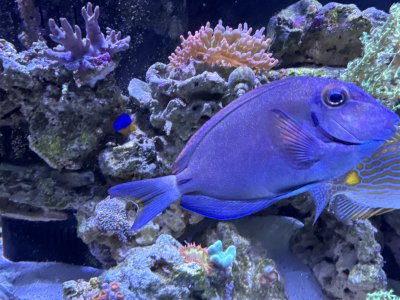Spectorman
Member
Hey y’all
Been a while. I have been battling marine ich for about a month and a half mostly with Hydrogen Peroxide and ginger. I am aware my methodology is a bandaide but my fish are MOSTLY happy a show no signs of ich like they had. For now things are……..ok.
My tank is 10months old and looks fantastic. All of my fish were tiny including my engineer goby. To me he had always looked cloudy kind of. Not super black but kind of a haze over his body. He’s almost 9”. He has always looked that way. I have nothing to compare it to so as far as I was concerned while it is odd…..he’s happy and eats like a pig.
I have a blue Caribbean tang. Who until maybe a month ago, kind of has a haze over him too. I noticed a couple days ago his eyes are more cloudy than the clear they normally are. My best guess is flukes.
I have had ich before as well as marine velvet. Both heartbreaking. I have never had this haze before. Nobody is struggling. Everyone is eating like pigs. Everyone else has bright colors and eyes. It’s a full on 200gallon mixed reef with a lot of rock. Is it normal to have a haze on two of the fish but none of the others. Or is there definitely a flukes issue with everyone the eventuality. They need to go to the hospital?
In my 20+ years in his sport have never seen this before. Mostly because unlike velvet where everything dies quickly, everything in my tank seems content, happy and eating. Am I missing something and it’s nothing to worry about or follow my spidey senses and get them out?
Thanks!
H
Been a while. I have been battling marine ich for about a month and a half mostly with Hydrogen Peroxide and ginger. I am aware my methodology is a bandaide but my fish are MOSTLY happy a show no signs of ich like they had. For now things are……..ok.
My tank is 10months old and looks fantastic. All of my fish were tiny including my engineer goby. To me he had always looked cloudy kind of. Not super black but kind of a haze over his body. He’s almost 9”. He has always looked that way. I have nothing to compare it to so as far as I was concerned while it is odd…..he’s happy and eats like a pig.
I have a blue Caribbean tang. Who until maybe a month ago, kind of has a haze over him too. I noticed a couple days ago his eyes are more cloudy than the clear they normally are. My best guess is flukes.
I have had ich before as well as marine velvet. Both heartbreaking. I have never had this haze before. Nobody is struggling. Everyone is eating like pigs. Everyone else has bright colors and eyes. It’s a full on 200gallon mixed reef with a lot of rock. Is it normal to have a haze on two of the fish but none of the others. Or is there definitely a flukes issue with everyone the eventuality. They need to go to the hospital?
In my 20+ years in his sport have never seen this before. Mostly because unlike velvet where everything dies quickly, everything in my tank seems content, happy and eating. Am I missing something and it’s nothing to worry about or follow my spidey senses and get them out?
Thanks!
H

